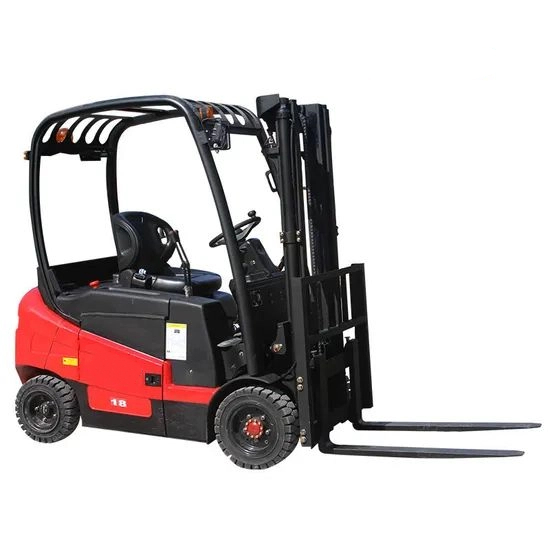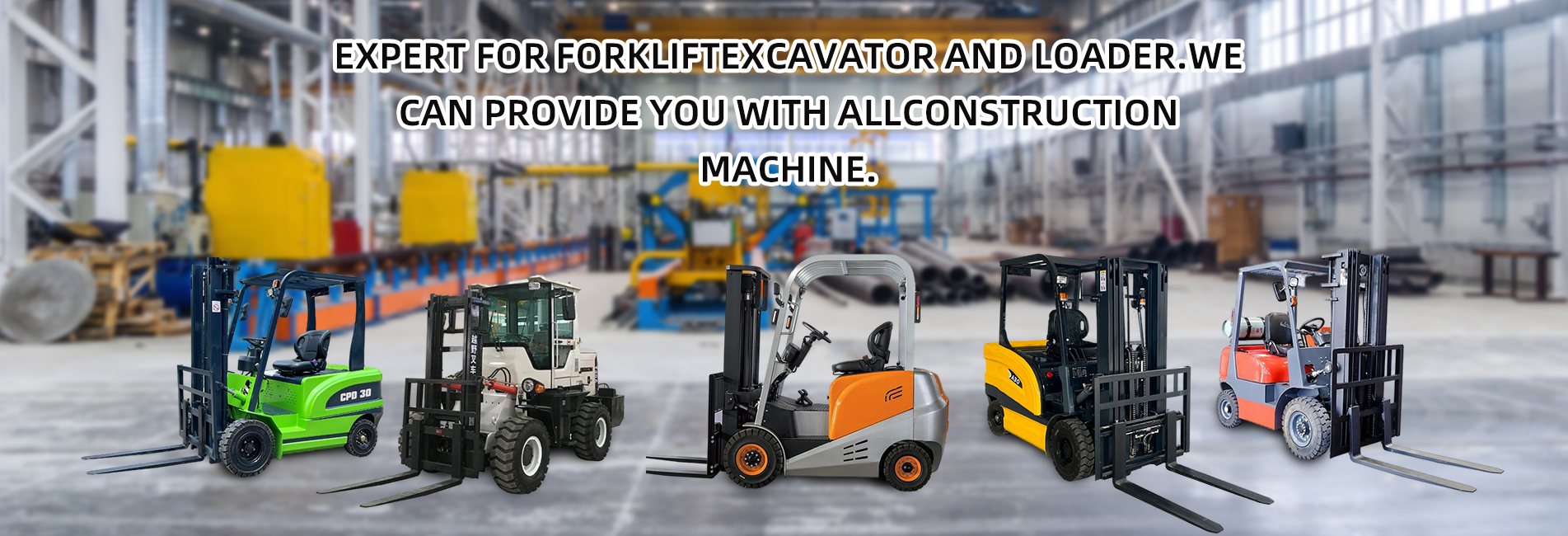When choosing a forklift with the same tonnage, focus should be placed on core factors such as the working scenario, load characteristics, and operating environment. The following are specific selection dimensions and suggestions to help accurately match your needs:

I. Core Distinction Dimension: Power Type (Affecting Usage Scenarios and Costs)
Electric Forklifts
- Applicable Scenarios: Indoor operations (e.g., warehouses, workshops, supermarkets), places with high environmental protection requirements (e.g., food factories, pharmaceutical factories), and noise-sensitive areas (e.g., warehouses near residential areas).
- Advantages: Zero emissions, low noise (≤65 decibels), easy operation (fast response of motor drive), low maintenance costs (no need to replace engine oil, filters, etc.), and low energy consumption costs (electricity prices are lower than fuel prices).
- Limitations: Range depends on batteries (single charge lasts 4-8 hours, requiring supporting charging piles), relatively heavy weight (batteries increase self-weight, which may affect ground bearing capacity), significant decrease in battery capacity in low-temperature environments (<0°C), and weak climbing ability (usually ≤15% slope).
- Priority Selection Situations: Fixed sites, short-distance transportation, indoor-dominated operations, and high-frequency light loads (e.g., sorting areas in e-commerce warehouses).
Internal Combustion Forklifts (Diesel/Gasoline/Liquefied Petroleum Gas - LPG)
- Diesel Forklifts:
- Applicable Scenarios: Outdoor operations (construction sites, ports, freight stations), continuous heavy-load operations (e.g., container loading and unloading), and rough roads (sand yards, factory raw material areas).
- Advantages: Strong power (high torque, climbing ability ≥20%), unlimited range (refueling is sufficient), resistance to high and low temperatures (stable operation from -20°C to 40°C), and high durability (suitable for harsh environments such as dust and mud).
- Limitations: Polluting emissions (black smoke, exhaust gas), high noise (≥85 decibels), frequent maintenance (regular oil and filter changes required), and high energy consumption costs (high fuel prices).
- Gasoline/LPG Forklifts:
- Applicable Scenarios: Light outdoor operations (e.g., small logistics parks) and outdoor scenarios with slightly higher emission requirements (e.g., warehouses in suburban areas).
- Advantages: Cleaner emissions than diesel vehicles (LPG has almost no black smoke), good starting performance (easy to start at low temperatures). Gasoline forklifts are suitable for short-distance flexible operations, and LPG can switch fuels (balancing environmental protection and range).
- Limitations: Less powerful than diesel vehicles (not suitable for continuous heavy-load operations), high fuel consumption of gasoline vehicles, and LPG requires supporting gas cylinder storage devices (taking up space).
II. Key Functional Parameters (Matching Load and Operational Needs)
Mast Type and Lifting Height
- Standard Mast: Lifting height of 3-5 meters, suitable for ground stacking and low-shelf warehouses (e.g., traditional factory workshops).
- Two/Three-Section Mast: Lifting height of 5-12 meters, suitable for high-shelf warehouses (e.g., e-commerce three-dimensional warehouses). Attention should be paid to the stability of the mast after lifting (the higher the height, the more attention should be paid to the forward and backward tilt angles).
- Full-Free Mast: The mast does not move backward when lifting, suitable for narrow passages (e.g., operations inside containers).
Forks and Attachments (Adapting to Load Characteristics)
- Standard Forks: Suitable for handling regular palletized goods (e.g., cartons, wooden boxes). The length of the forks should be confirmed (usually 1-2 meters; long forks are suitable for handling long items such as steel).
- Special Attachments:
- For irregular goods (e.g., barrel materials, cloth, glass): Choose clamps, side shifters, or rotating forks.
- For heavy or high-temperature goods (e.g., steel coils, castings): Choose thickened forks with anti-slip pads, and match with weighing attachments (to avoid overloading).
- For stacked goods (e.g., tires, barrels): Choose pushers or tilting forks.
Wheelbase and Turning Radius
- Short-Wheelbase Forklifts: Small turning radius (≤2.5 meters), suitable for narrow passages (e.g., warehouse shelf spacing ≤3 meters). They are highly flexible but have slightly poor stability at high speeds.
- Long-Wheelbase Forklifts: Large turning radius (≥3 meters), suitable for open sites (e.g., freight stations, outdoor yards). They are more stable at high speeds and have a more stable load center (suitable for offset loads).
III. Special Requirements for the Operating Environment
Ground Conditions
- Smooth Hardened Ground (Concrete/Asphalt): Priority is given to electric forklifts (protecting the ground, no oil pollution) or standard internal combustion forklifts.
- Rough/Muddy/Outdoor Ground (Gravel, Construction Sites): Choose diesel forklifts (tires can be pneumatic or solid; solid tires are puncture-resistant and suitable for gravel roads).
- Ground with Limited Bearing Capacity (e.g., floor warehouses, light floors): Choose electric forklifts (lighter weight, or lithium battery forklifts for further weight reduction).
Operational Intensity
- High-Frequency Operations (>8 hours per day): Choose internal combustion forklifts (diesel vehicles have higher durability and do not require mid-charge) or large-capacity battery electric forklifts (equipped with fast charging function).
- Low-Frequency Intermittent Operations (<4 hours per day): Electric forklifts are more economical (low maintenance costs and energy savings).
Special Environmental Restrictions
- Explosion-Proof Environments (e.g., chemical warehouses, gas stations): Choose explosion-proof electric forklifts (motors and circuits meet explosion-proof standards to avoid sparks).
- High-Temperature Environments (e.g., steel mill workshops): Choose high-temperature-resistant internal combustion forklifts (equipped with heat insulation devices to prevent overheating of hydraulic oil and tires).
- Low-Temperature Environments (e.g., cold storage): Choose cold storage-specific electric forklifts (batteries and hydraulic systems are adapted to -20°C low temperatures to avoid freezing failures).
IV. Auxiliary Decision-Making Factors
Maintenance and After-Sales Service
- Electric Forklifts: Simple structure (no engine) with few maintenance points, but batteries need regular inspection (to avoid overcharging and over-discharging) and rely on brand after-sales service (battery maintenance requires high professionalism).
- Internal Combustion Forklifts: Many maintenance points (engine, gearbox, oil circuit), but maintenance outlets are more common (especially diesel vehicles, suitable for remote areas).
Purchase Cost and Lifecycle
- Electric Forklifts: High purchase cost (30%-50% higher than internal combustion vehicles of the same tonnage), but low long-term use costs (savings in electricity and maintenance fees), suitable for scenarios with a service life of >5 years.
- Internal Combustion Forklifts: Low purchase cost and low short-term investment, but high fuel consumption and maintenance fees, suitable for short-term projects or low-frequency use.
Summary: Core Logic for Selecting Forklifts of the Same Tonnage
- Indoor + Environmental Protection + Low Intensity: Electric forklifts (prefer lithium batteries for better range).
- Outdoor + Heavy Load + High Intensity: Diesel forklifts (choose solid tires to adapt to complex roads).
- Both Indoor and Outdoor + Medium Load: LPG forklifts (balance emissions and range).
- Special Scenarios: Lock in special models according to environmental requirements (explosion-proof, cold storage, narrow passage, etc.).
Final Suggestion: Combine the floor plan of the operation site (confirm passage width and shelf height), daily operation duration, and load type (whether with pallets, whether offset load), and prioritize test-driving the same type of forklifts to experience operational flexibility and adaptability before making a decision.


